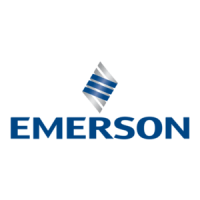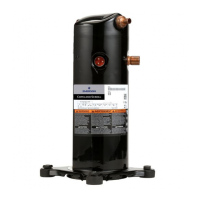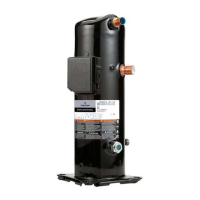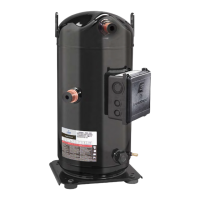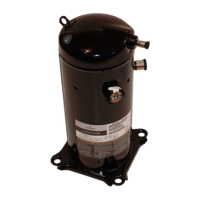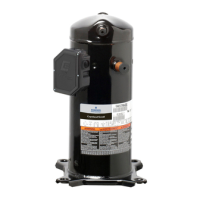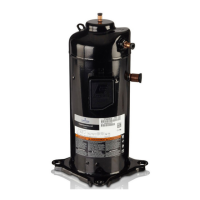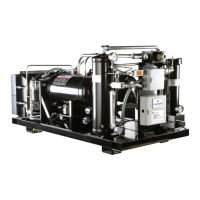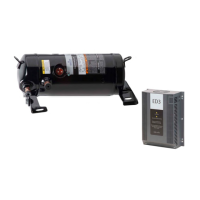12
© 2015 Emerson Climate Technologies, Inc.
AE4-1400 R1
Copeland Scroll compressors leave the factory
dehydrated and with a positive dry air charge. Plugs
should not be removed from the compressor until
thecompressorhashadsufcienttimetowarmupif
stored outside and is ready for assembly in the unit.
The suggested warm up time is one hour per 4°F (2K)
difference between outdoor and indoor temperature. It is
suggestedthatthelargersuctionplugberemovedrst
to relieve the internal pressure. Removing the smaller
discharge plug could result in a spray of oil out of this
ttingsince someoil accumulatesin thehead ofthe
compressor after Emerson’s run test. The inside of both
ttingsshouldbewipedwithalintfreeclothtoremove
residual oil prior to brazing. A compressor containing
POE oil should never be left open longer than 5 minutes.
Suction Funnel
The ZPK6 compressor includes a suction funnel which
isboltedontothexedscrollinternally.Thefunnelcan
be seen by looking through the suction tube from the
outside of the compressor. Please see Figure 8 for
pictorial views.
It is important that nothing is inserted into the
suction tube further than the normal depth of the
unit suction tube assembly.
Assembly Line Brazing Procedure
WARNING
Personal safety equipment must be used during
brazing operation. Heat shields should be used to
prevent overheating or burning nearby temperature
sensitive parts. Fire extinguishing equipment
should be accessible in the event of a re.
Figure 6 discusses the proper procedures for brazing
the suction and discharge lines to a scroll compressor.
NOTICE It is important to ow nitrogen through the
system while brazing all joints during the system
assembly process. Nitrogen displaces the air and
prevents the formation of copper oxides in the system.
If allowed to form, the copper oxide akes can later
be swept through the system and block screens such
as those protecting capillary tubes, thermal expansion
valves, and accumulator oil return holes. Any blockage
of oil or refrigerant may damage the compressor
resulting in failure.
Pressure Testing
WARNING
Never pressurize the compressor to more than
475 psig (32.8 bar) for leak checking purposes.
Never pressurize the compressor from a nitrogen
cylinder or other pressure source without an
appropriately sized pressure regulating and relief
valve.
The pressure used on the line to meet the UL burst
pressure requirement must not be higher than 475
psig (33 Bar). Higher pressure may result in permanent
deformation of the compressor shell and possible
misalignment or bottom cover distortion.
Assembly Line System Charging Procedure
Systems should be charged with liquid on the high
side to the extent possible. The majority of the charge
should be pumped in the high side of the system to
preventlowvoltagestartingdifculties,hipotfailures,
andbearingwashoutduringtherst-timestartonthe
assembly line. If additional charge is needed, it should
be added as liquid to the low side of the system with
the compressor operating. Pre-charging on the high
side and adding liquid on the low side of the system are
both meant to protect the compressor from operating
with abnormally low suction pressures during charging.
NOTICE Do not operate the compressor without
enough system charge to maintain at least 55
psig (3.8 bar) suction pressure. Do not operate
the compressor with the low pressure cut-out
disabled. Do no operate with a restricted suction
or liquid line. Depending on the discharge pressure,
allowing pressure to drop below 55 psig (3.8 bar) for
more than a few seconds may overheat the scrolls and
cause early drive bearing damage. NOTICE Do not
use the compressor to test the opening set point of
a high pressure cutout. Bearings are susceptible to
damage before they have had several hours of normal
operation for proper break in.
“Hipot” (AC High Potential) Testing
CAUTION
Use caution with high voltage and never hipot
when compressor is in a vacuum.
CopelandScrollcompressorsareconguredwiththe
motor down and the pumping components at the top
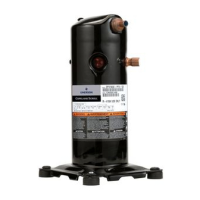
